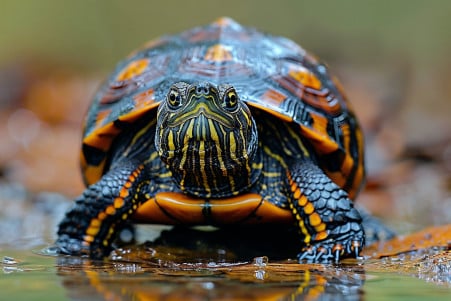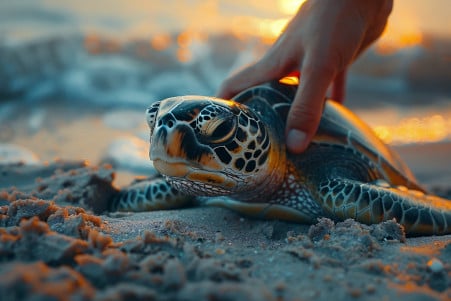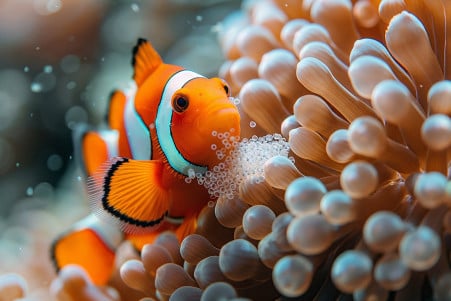Why Is My Hermit Crab Naked? The Science of Crab Behavior
5 February 2024

When a hermit crab is outside of its shell, it’s not just vulnerable; it’s a puzzle waiting to be solved. Hermit crabs can leave their shells due to a variety of factors, including growth, discomfort, stress, or environmental conditions. If your crab has left its shell, make sure to offer a variety of suitable shells in a safe, humid environment to help it get back into a shell as soon as possible.
To help you better understand this fascinating behavior, we’ll look at studies from marine biology, ethology, and environmental science.
We’ll also take a deep dive into research on hermit crab behavior, the physiological stress responses that can lead to shell abandonment, and the ways that habitat can impact these interesting animals. By the end of this article, you’ll know everything there is to know about why a hermit crab might abandon its shell and what to do if it happens.
Why is my hermit crab naked?
Understanding Hermit Crab Molting: Life Cycle and Shell Vacancy
Much like a snake molting its skin, molting is a natural and necessary part of a hermit crab’s life cycle. According to Learn About Nature, hermit crabs must molt to grow, because they have to shed their old exoskeleton to make room for a new, larger one.
This process happens about every 18 months, although younger crabs may molt more frequently. When hermit crabs molt, they often leave their shells and bury themselves to protect themselves, which can cause people to think they are sick or dead.
According to PetHelpful, signs that a hermit crab is about to molt include lethargy, cloudy eyes, and a lack of movement, especially in their antennae. It’s important to set up an isolation area with the right heat and humidity to ensure a successful molt, because this will help the crab form its new exoskeleton.
The Spruce Pets suggests keeping the temperature between 78 and 80 degrees Fahrenheit and the humidity between 78% and 80% to ensure the best environment for molting.
While molting can lead to a period of shell vacancy, a properly set up isolation area will help the hermit crab grow in a safe and healthy way. It’s important to make sure that hermit crabs are protected and supported during this time of growth, because their safety and health are dependent on their caregivers’ ability to understand and meet their needs.
How to Set Up the Perfect Hermit Crab Habitat
The well-being of hermit crabs is largely dependent on their environment, and temperature and humidity are especially important. The Spruce Pets explains that it is important to keep the temperature in a hermit crab’s habitat at a warm, tropical level, which means keeping it between 72 and 80 degrees Fahrenheit.
The humidity should be kept between 70–80%. If the temperature and humidity are not kept at these levels, it can cause stress to the hermit crabs, which can lead to them leaving their shells in an attempt to find a more comfortable environment.
To set up the right environment, start with a 10-gallon tank and use under-tank heaters and water bowls to maintain the right temperature and humidity. Then, add climbing structures and a variety of clean shells to the tank to encourage natural behaviors and reduce stress. Finally, the Smithsonian National Zoo suggests adding plants, moss, and leaf litter to the tank to mimic the hermit crabs’ natural environment and give them a food source.
By maintaining this environment, you are helping to ensure the health of the hermit crab and the safety of their shell. Without this environment, hermit crabs can become more stressed and vulnerable, which can lead to a number of behaviors that are not ideal.
Understanding the Stress That Leads to Shell Abandonment
When hermit crabs are stressed, they experience a variety of hormonal and behavioral changes. For example, a study by Phillip R. Taylor published in ScienceDirect found that hermit crabs were more likely to abandon their shells when they were subjected to temperature and desiccation stresses, indicating that the crabs were adjusting their behavior in response to environmental stressors.
Meanwhile, a study by Robert W. Elwood, published in Biology Letters, showed that European shore crabs had a strong physiological stress response, including a rise in lactate levels, when they were subjected to electric shocks.
This is important because it helps to show that hermit crabs are capable of experiencing stress and that they may abandon their shells as a last resort to deal with stressful situations.
A study by Brian Kai Hin Leung, cited in PubMed, found that hermit crabs were more likely to exhibit these behaviors in response to extreme temperatures, and that during heat stress, they would lift their shells to help regulate their body temperature.
Together, these studies show that stress has a significant impact on the physiological state of hermit crabs, which can lead to behaviors like shell abandonment. This knowledge of stress responses and their impacts can help us better understand hermit crab well-being and provide more insight into their behavior.
Finding a Home: Hermit Crabs and Shell Selection
Hermit crabs are picky when it comes to choosing a new shell. A study in the Journal of Shellfish Research found that hermit crabs prefer shells that are free of damage and will change shells when given the opportunity, especially if there is no competition or predation.
The study found that the size, weight, and the species of the original gastropod inhabitant all played a role in the hermit crabs’ shell selection. Another study in the same journal found that larger hermit crabs change shells more often, which suggests that growth and fit are important components of their shell selection.
Shell availability is a big part of hermit crab well-being. If there are not enough shells for hermit crabs to choose from, they may leave their current shells in search of a new one. One study on PubMed found that hermit crabs are attracted to calcium-bearing surfaces, which likely helps them differentiate between shells and other objects. This instinctual behavior shows the importance of having enough shells available to avoid unnecessary stress and vulnerability.
In addition, microplastic pollution is a new threat to shell selection. A study in Biology Letters found that microplastics can interfere with shell selection, causing hermit crabs to take longer to find a new shell or even avoid them altogether.
This kind of interference with natural behaviors could lead to more shell abandonment, which shows the importance of conservation efforts to protect the hermit crabs’ habitats.
A better understanding of the delicate balance hermit crabs strike when choosing a shell can help us better understand the complex relationship between their biology and the environment, which can lead to more effective conservation efforts and pet care.
The Mystery of the Empty Shell: What We Know About Hermit Crab Behavior
In the end, it is clear that there are many reasons that a hermit crab might leave its shell. However, each of these reasons is interesting and important. From the natural process of molting to the search for the perfect living conditions, each of these factors is important to the crab’s well-being.
Stress, whether it is physiological or due to changes in the environment, and the availability and quality of shells are also reasons that a crab might leave its shell.
This study shows how important it is to understand the needs of hermit crabs, from knowing when they are molting to understanding the importance of the conditions in their environment. Good hermit crab owners will make sure that they have a variety of shells to choose from and that the environment they live in is stable and free from stress so that the crabs can exhibit their natural behaviors.
In conclusion, we can see that hermit crabs are part of a complex web of life. Their behavior is a window into a world of delicate ecological balances and biological needs. As the people who care for these animals, we have the honor and the responsibility of helping them live healthy and safe lives through our careful attention and care.


